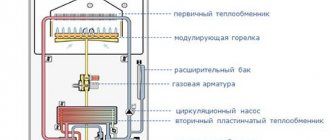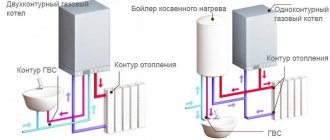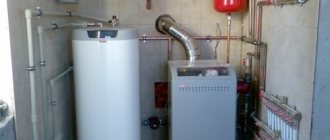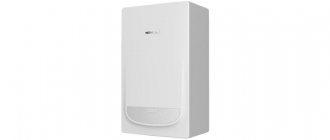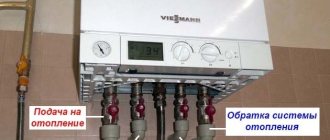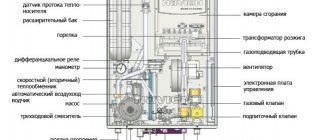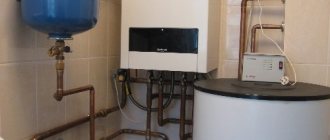The most important question that owners of country houses have when installing a new heating system or reconstructing an old one is how not to make a mistake when choosing a boiler and where to put it. Wall-mounted or floor-mounted, conventional (convection) or condensation, single/double-circuit, with natural draft or coaxial chimney. The choice is actually huge. And for it to be correct, you need to have a rough idea of the design features and basic operating algorithms. Therefore, we will figure out which one is better and why.
Design features, fundamental differences
A single-circuit boiler is used for heating premises by heating the coolant using 1 heat exchanger built into the boiler. Gas boilers, the design of which involves two heat exchangers, i.e. separately heating the coolant water for heating and hot water supply - called double-circuit.
Photo from ktl.by
Devices are classified:
- by location - floor and wall;
- in terms of energy efficiency: conventional, using a low calorific value and condensing, designed to consume a higher calorific value of fuel with the additional use of thermal energy released with condensate from water evaporation;
- according to the design of the gas burner - with an open and closed combustion chamber.
We also recommend reading: floor-standing or wall-mounted gas boiler, which is better and Top 10 best floor-standing gas boilers
When operating a gas boiler room, it is necessary to remember that gas is not only a benefit, but also a source of increased danger. Therefore, independent installation of equipment can lead to gas leaks and irreparable consequences.
To put it into operation, you must obtain a package of permits and consult with a specialist. It’s even better to entrust heating installation to professionals. You should not save on the health of your loved ones.
Nuances of installing heating systems
When the combustion chamber is open, it is necessary to install a chimney for the boiler.
For gas-powered equipment, a project for its installation must be made. If you have some freedom in choosing where to mount the boiler, you can specify some points that will help the device operate more correctly.
It is advisable to mount flow heaters closer to the place where the water intake will be.
If there are two coolant release valves, the distance from the heater should be minimal to the valve from which water is most often taken.
Differences in the design of single and double circuit units
What is the difference between the design of units with 1 circuit and with 2 circuits? If we talk about the main components, then the basic principle of operation is the same for both types of equipment:
- pipelines through which water is supplied from a well (water supply);
- expansion tank;
- smoke exhaust or coaxial pipe and burner.
One of the main things that distinguishes a single-circuit gas boiler from a 2-circuit one is the design of the heat exchanger.
If in a 1-circuit it is a pipe through which water is heated due to the exchange of heat from a gas burner, in a 2-circuit it is two double heat exchangers made of pipes and plates or one bithermal (to make it clearer, this is a pipe inside a pipe).
- primary, heating heating circuit;
- secondary or plate, responsible for heating the water.
Photo from https://teplowood.ru
However, the key difference is the 3-way valve, which is responsible for the direction of water. When the heating circuit heats up, the valve is in its normal position. However, when the DHW tap is opened, the device’s automation is activated due to the pressure difference. The valve blocks the access of hot water to the heating circuit. Then the coolant begins to circulate inside the boiler. At this moment the room is no longer heated.
How to choose?
To choose an electric boiler, the client should pay attention to the characteristics of the devices; they should also be taken into account before purchasing
Number of circuits
Single-circuit boilers heat the coolant in the heating system. To provide hot water, you should choose an additional water heater or a double-circuit boiler.
Their design includes two operating circuits, one for heating, the other for providing hot water. But these boilers consume a lot of electricity, increasing the cost of water and heating.
Power
The main parameter you need to pay attention to is the power of the electric boiler. It is worth considering the area and intensity of heat loss of the building
When the supply voltage decreases, the power also decreases.
If you use a double-circuit electric boiler for hot water supply, then a power reserve of up to 25% is provided.
Supply voltage
The next point is the type of supply voltage. Most often, boilers have low power, and the power comes from a single-phase 220V network.
If you need to connect more powerful equipment up to 10 kW, then you should lay a separate connection line.
Equipment
The basic equipment of the unit consists of the following elements: circulation pump, expansion tank, safety group, temperature sensors and programmer.
Safety
Additional protective devices of the device will help save electricity and protect the owner from breakdowns. The fuse is located outside the device.
NOTE! It is advisable that the fuses have different directions - they are triggered by overheating, freezing of the coolant, or critical measurement of electricity data.
Installation
When installing, it is worth considering the location where the unit is installed. This can be wall mounted or floor mounted.
For heating a private home, a wall-mounted installation is more suitable. But if the device is large, the client may only have the full version. In this case, it is worth putting the unit away in a storage room or a special boiler room in the house.
For an average apartment, it is better to choose a wall-mounted design of devices.
Heated area (calculation)
It is worth taking as an example the calculation for a room of 18 sq.m., the formula will look like this:
18 sq.m x 100 W = 1800 W
It turns out that an hour of heating eighteen square meters will require 1.8 kW of power. The result is divided by the heat that is released into a certain part of the heating radiator.
If we take into account the data from the 170 W passport, then we should:
1800 W/170 W = 10.59
The resulting number is rounded up to the nearest whole number - 11. Therefore, it follows that for an area of 18 sq.m, it is recommended to purchase a unit with 11 sections.
To heat an area of 160 m2, the boiler power should be 16 kW.
It is worth making a calculation for an apartment area of 65 m2 with three-meter ceilings:
- Determine the power by area - 65m2/10m2 = 6.5 kW;
- An adjustment is made for the region - 6.5 kW * 1.2 = 7.8 kW;
- 25% should be added, taking into account water heating 7.8 kW * 1.25 = 9.75 kW;
- 10% is added to account for cold temperature: 7.95 kW * 1.1 = 10.725 kW.
The result is rounded to a power of 11 kW.
Control
When choosing a control, you should consider the convenience of the design and ease of use. Basically, boilers have electronic panels with several keys and a rotary switch. But there is also something completely mechanical.
It all depends on the personal preferences of buyers, which it is advisable to voice before purchasing.
Additional functions
When paying attention to additional functions, take into account the built-in controls that complement the functionality. All additional options also need to be checked with the manager in a specialized store.
All additional options also need to be clarified with the manager at a specialized store.
- Protection from cold temperatures;
- Fuses are installed to prevent excessive temperatures;
- Thermometer for determining temperature;
- Indication when the device is activated;
- Blocking nas also has protection;
Comparative review of gas boilers
Boilers with one heat exchanger are responsible only for supplying heat to the room; organizing hot water supply is not their task. In this regard, they are inferior to devices with two heat exchangers. The installation of an indirect heating boiler will allow you to expand the functionality, but then additional expenses are inevitable.
Also read with this article: Connection diagram for a single-circuit and double-circuit gas boiler with an indirect heating boiler
For clarity, we structure the information according to comparison criteria and present it in the form of a table.
| Single-circuit | Single-circuit with indirect heating boiler | Dual-circuit | |
| Possibility of installation (floor/wall) | +/+ | +/+ | +/+ |
| Additional expenses | – | + (for the purchase and connection of a boiler) | – |
| Economical | + | + | – (constant operation of the second DHW circuit when using water) |
| Compactness | + (in the absence of a boiler) | – (requires additional space for the boiler) | + |
| Comfort | – (when connecting the DHW circuit, the DHW and heating temperatures are not regulated) | – (temperature does not change at all points of DHW use) | – (when using more than two points, the water temperature may change sharply) |
Read about saving blue fuel in the article: How to save gas when heating a private home
About ease of use
What to choose for those who are not used to putting up with discomfort, but still want to comfortably use the benefits of civilization? For these purposes, single-circuit boilers are created as opposed to double-circuit boilers. Such a device is designed to heat heating fluid, but if you connect an indirect heating boiler to it, you can get a modern, efficient hot water system.
Further, with the use of a boiler, the following can be noted: the boiler begins to heat the water only from the moment it begins to cool for some reason. This means that it is possible to create a special recirculation system, i.e. movement of hot water in a circle. The water will bypass each tap and return to the boiler for further heating. In this case, we get hot water immediately after opening the tap - because the water will already be there. This is very important if you plan to build a large house with several bathrooms, and they are quite far from the boiler room
Advantages and disadvantages
When installing autonomous heating, gas equipment becomes the optimal solution. This choice is explained by its high efficiency (90%), variety of models and manufacturers, versatility of use, compactness, ease of maintenance and relatively quick payback.
Before deciding which is better - a single-circuit or double-circuit gas boiler, let's consider the pros and cons of each of them.
Single-circuit units
The main advantage of this type of equipment is its simplicity of design, therefore, unlike double-circuit equipment, it is characterized by higher reliability and fewer breakdowns.
The operation does not depend on the pressure in the water supply system. The advantages include low equipment cost and excellent performance.
When there is no need for hot water, there are practically no disadvantages, but then versatility and functionality are reduced.
If for a comfortable stay you need to provide access to hot water, then there will be a need to purchase and install additional equipment. As a result, the area for its placement will increase and it will be necessary to equip the boiler room.
Double-circuit boiler
This may seem strange, but a 2-circuit boiler is cheaper in price. The difference in cost is small, but it is there.
Such devices are usually low-power and compact. They can be installed not in separate special boiler rooms, but, for example, in the kitchen or hallway. The main thing is that the status of the premises is non-residential. This prevents installation in the kitchen - living room, for example.
The living room is a living space.
There is a huge variety of dual-circuit gas units on the market.
Read more: Top 10 best double-circuit boilers.
This allows you to select the desired power option. At the same time, they fit quite well into the interior. There are consumers who are concerned about the noise when the device operates. However, all the worries are really in vain. The volume of the boiler is comparable to that of a refrigerator. A little time will pass and additional extraneous sounds will be in order.
We recommend reading: Requirements for the room for installing the boiler
Additional advantages of a 2-circuit boiler include the possibility of complete autonomy. You just need to set the temperature, set the time, and the boiler will turn on and off automatically according to the specified settings. Plus, the device informs about any malfunctions and performs an emergency shutdown. See the table below for convenience.
| Advantages | List of disadvantages |
| The device is compact and takes up little space | if the family is more than two people, then prepare for the fact that there will not be enough hot water |
| there is a separate circuit for DHW | water temperature is not adjustable |
| The delivery set includes a circulation pump and a membrane tank | if the cold water pressure is low, then the hot water pressure will be the same |
| with the same parameters, the equipment has higher power | When you open the tap, cold water flows for a few seconds, and only then hot water. You need to get used to this too |
| ease of installation and connection | since heating of the room stops when the hot water system is turned on, then with prolonged use of hot water, the temperature in the heating radiators can decrease noticeably |
| Possibility of use in the warm season without turning on the heating |
However, issues with the order of water procedures can be resolved. As for the rest, if you monitor the technical condition and change components on time, the equipment will last for many years.
Which boiler is better to choose: comparison of differences between single-circuit and double-circuit models
The durability of its operation, the comfort of residents and heating costs depend on how correctly the equipment is chosen.
When the question arises, which boiler is better, you must take into account its power. Most often they start from the fact that for heating 10 square meters. meters requires 1 kW. However, these figures are averaged, and first of all, the heat loss of the building must be taken into account.
Dimensions
Based on the type of installation, they are classified into floor-mounted and wall-mounted. The floor-standing equipment uses a volumetric cast-iron heat exchanger. Although they last longer than wall-mounted ones, they have greater weight and dimensions. In addition, their installation is more difficult. If we talk about the characteristics, the wall-mounted version is better, while the floor-mounted one is simpler, without complex automation.
Calculation of gas consumption for a one-room apartment
To heat 10 square meters you need 1 kW of boiler power. To obtain 1 kW of thermal energy, you need to burn 0.1 m³ of gas per hour. I have 40 square meters of one-room apartment, I will use autonomous heating for the first time: 4 kW * 0.1 m³ = 0.4 m³/hour.
Let's roughly estimate that there will be 3 really cold months, and 4 off-season months, then the boiler will oil at full capacity for 90 days and at half power for 120 days. We calculate the gas consumption per day for the cold months: 4 x 0.1 x 24 ≈ 10 m³, in the off-season ≈ 5 m³. The entire heating season: (10 x 90) + (5 x 120) = 1500 m³.
Let's add hot water consumption to this figure. My super-economical family of 2 people uses about 2 cubic meters of gas per month, and in the kitchen we use mainly cold gas. I calculate according to the heating season: 2 m³ x 7 months = 14 m³. Cooking takes about 4 m³ of gas, we often cook in a multicooker, there is no gas oven: 4 m³ x 7 = 28 m³. We get this figure for the heating season: 1500+14+28 = 1542 m³, I’ll round it up to 1600 m³, just in case.
The gas tariff for the heating season (2015, Ukraine) is 3.60 UAH per m³ with a consumption of no more than 200 m³ per month, or $0.16. If you cross the line of 200 m³ in a month, the remaining cubes cost 7.19 UAH. I will presumably pay for the heating season: 1600 m³: 7 ≈ 229 m³, (200 m³ x 3.6)+(29 m³ x 7.19) ≈ 930 UAH, $40 per month, or 930 x 7 = 6500 UAH, $280 per season .
Judging by the gas consumption of normal people (I collected data on online forums), my calculations are still quite modest. And it's depressing. Outside of benefits for the heating season, which is 5 months a year, the tariff is 7.19 per m³. My 6 m³ costs 43 UAH ≈ $2.
The question arose: will water heated by an electric boiler be cheaper than gas? At least outside the heating season? Let's do the math.
Dependence of the heating system on piping and power supply
To ensure the functionality of boilers, all types of boilers are provided with a standard set of equipment sufficient to generate heat from the fuel consumed. Each model has a combustion chamber and a heat exchanger.
Boilers can be powered by a solid liquid or gaseous energy source. Depending on the type of fuel used, the design of the combustion chamber changes. The heat exchanger is also undergoing some improvements to increase the efficiency of the entire device.
The boiler model is selected taking into account the heating system with which the house is equipped. Or vice versa - pipes and radiators are installed taking into account the capabilities of the already purchased boiler. In this case, maximum efficiency of the equipment is ensured.
For a heating system with natural hydraulic circulation of coolant, it is enough to purchase a boiler of the simplest design. Once you have set the fuel combustion mode and adjusted the coolant flow using valves on the pipes, you obtain acceptable temperature conditions for the entire season. Boilers with increased functionality are equipped with thermostats, heat sensors, and automatic room temperature controllers.
Depending on the type of heating system connected to the boiler, it may contain a circulation pump that pushes water into the heat exchanger. In this case, the device must be provided with an uninterrupted power supply. Stopping the circulation pump will stop the migration of water in the system. To eliminate dependence on power supply, a pipework with natural coolant circulation is installed.
Kinds
There are several design options for floor-standing single-circuit boilers. They differ from each other in various ways.
By type of combustion chamber:
- atmospheric (open). The air directly surrounding the boiler is used, and the smoke is removed under the influence of natural draft. Such models are connected only to the central vertical chimney;
- turbocharged (closed). To supply air and remove smoke, a coaxial type chimney is used (pipe in pipe), or two separate pipelines that perform the functions of intake and supply of air to the boiler and exhaust of flue gases.
According to heat exchanger material:
- steel. The most common option used on inexpensive models.
- copper. The coil-shaped design increases the path of liquid passing through the heating zone. Such units are installed in expensive models from top manufacturers;
- cast iron. Installed on powerful and massive units. Cast iron heat exchangers demonstrate high performance, efficiency, and are capable of developing large units of power. Used for units from 40 kW and above.
By heat transfer method:
- convection Conventional heating of the coolant in the flame of a gas burner;
- parapet. They are able to do without a heating circuit, being a kind of analogue of a conventional stove;
- condensation The coolant is heated in two stages - first in the condensation chamber, from the heat from the condensing flue gases, and then in the usual way.
NOTE! Condensing boilers are able to fully operate only with low-temperature systems (warm floors), or when the difference in temperature outside and indoors is no more than 20°. These conditions are not suitable for Russia.
What to look for when buying a boiler
- Burner. The economical operation of the boiler depends on it. It is important that the burner design facilitates high-quality mixing of gas and air, and therefore complete combustion of the fuel without chemical underburning. The most economical are automatic burners with a built-in fan. Before being fed into the furnace, the gas is mixed with air and then fed into the boiler. The disadvantage of such a burner is the additional noise created by the fan.
- Heat exchanger. The quality of heat transfer from combustion products to the environment depends on the material of the heat exchanger. The best choice would be a heat exchanger made of steel or copper. They are distinguished by high thermal conductivity and resistance to aggressive environmental influences. In addition, it should be taken into account that under the influence of high temperatures and corrosion, its elements often fail. The more famous the boiler brand, the easier it will be to select a replacement part.
- Electronics and automation. The boiler, equipped with sensors and allowing operation to be adjusted by just pressing a few buttons, is simple and easy to use. But it is worth considering that if there is a power outage, the boiler protection will work and the fuel supply to it will stop. You should choose equipment that has the ability to manually regulate its operation in any case.
According to customer reviews, boilers of German and domestic production are considered the best. They are easy to maintain. Repair is also not difficult, since there are many service centers that order components and parts for repairs directly from the manufacturer. Boilers of Italian brands, on the contrary, have caused complaints from consumers due to a short warranty period, difficulties in repair and selection of spare parts. It is important to be careful when choosing a boiler. After all, it will last for decades and will create a feeling of comfort and coziness on winter evenings.
Answers from experts
Andrey Lukin:
single-circuit for heating only. double-circuit for heating and heating hot water (taking a bath). but what you were told is different. if the boiler operates without electricity (on natural draft) it is ATMOSPHERIC. if there is a SUPERCHARGED burner, then you need electricity
Dostoevsky and the cerebellum:
Single-circuit current heating, and double-circuit also heats water. And everything depends on electricity - there’s a pump that pumps water through pipes, and in some boilers there’s a lot of electronics themselves...
Verethragna Mitra:
electricity for the fan - blower, which supplies air to the nozzle, where it is mixed with gas and then ignited in the combustion chamber. For smoke extraction fan. Also, electricity (already autonomous) is used for safety, a thermocouple is installed (flame control), it generates an EMF, then through an amplifier and turns on the gas damper coil, when the flame goes out, the circuit opens and the damper falls, bimetallic plates are also used (switching off by temperature max. ) when heated, they bend and open the circuit; the circuit can also include an air pressure sensor on the burner, a pressure sensor. gas to the mountains , sensor on suction, pressure meters - sensors, off. boiler at min-max. gas pressure, shut-off valve, electromagnetic valve, etc. There are a lot of boilers... and everyone is different!
Hmansy:
The difference is whether you have hot water or not.
Alex Sharp:
single-circuit: drives water through only one set of pipes. In winter you have both heating and hot water. In the summer, if you want hot water, you have to turn on the heating and fry.
Double-circuit: There is a short pipe and valves on the primary circuit (two: at the inlet of the primary circuit and at the outlet. Additionally), by closing the valves, the boiler does not heat water in the entire system, but only in a small circuit. Without heating the house you have hot water.
There are boilers without electricity. I have a double-circuit Zhitomir. The water moves there thanks to the slight slope of the pipes and the law of physics (hot water rises to the ceiling and goes through the apartment, eventually dropping 12 m to 15 cm, then through radiators (like Soviet central heating batteries) it goes back to the boiler). No pump, no electricity! When lighting the torch (starting the boiler), there is a piezoelectric button on it (you can also light it with cotton wool in alcohol on a long rod, as I did, because the button is dead, and it’s expensive to buy it for ignition once a year...
alexm66:
A double-circuit boiler is smaller in size and easier to install: it has everything to connect the heating system. The downside is the overestimated heating power: the power is selected to heat water for hot water supply - they are rarely less than 24 kW (this power is enough to heat at least 240 sq. m of house area). Also, in a 2-circuit boiler, the heating system does not work while heating hot water. The single-circuit boiler + gas water heater system is very rare, except perhaps if the heating system is gravity-based - without a circulation pump. It is much easier to install a single-circuit boiler with an external boiler. The boiler smoothes out the need for boiler power - abroad they generally install special timers so that it heats up only at night: at this time they reduce the air temperature in the rooms. In terms of gas consumption, you won’t notice much of a difference. It will be more helpful if you insulate the house itself.
Mikhail Savelyev:
the ability to simultaneously heat water and heat the room using the same amount of gas
Grey:
single-circuit ones are simpler in design and maintenance, the column heats the water faster, which means gas savings,
Savva Schultz:
N***N:
there is an advantage. firstly, it is heating the water and there is no need to install a water heater or water heater; this is an extra expense and at the same time you save gas, which is still cheaper than electricity (if you have an Ariston) and spend money separately on the water heater!! ! Or better yet, buy a wall-mounted boiler, everything is there!!!
Rus Ivashkevitch:
The gas consumption of a double-circuit boiler definitely does not exceed the gas consumption of a boiler + column set. It has one heat exchanger, one burner, and a special valve that switches to water for washing hands or for heating. And the efficiency is definitely higher than that of a dual-circuit one. And the size of the double-circuit boiler is the same as the Neva column.
Sergey Telyshev:
Two in one is always worse. The advantage of a double-circuit boiler (IMHO not significant) is that it saves space. I’ve been using the boiler and heater for 7 years, I repair it and maintain it myself – I’m very pleased.
Dimon Rumyantsev:
With a 2-circuit boiler, hot water at a constant temperature will not flow. heats up slowly
